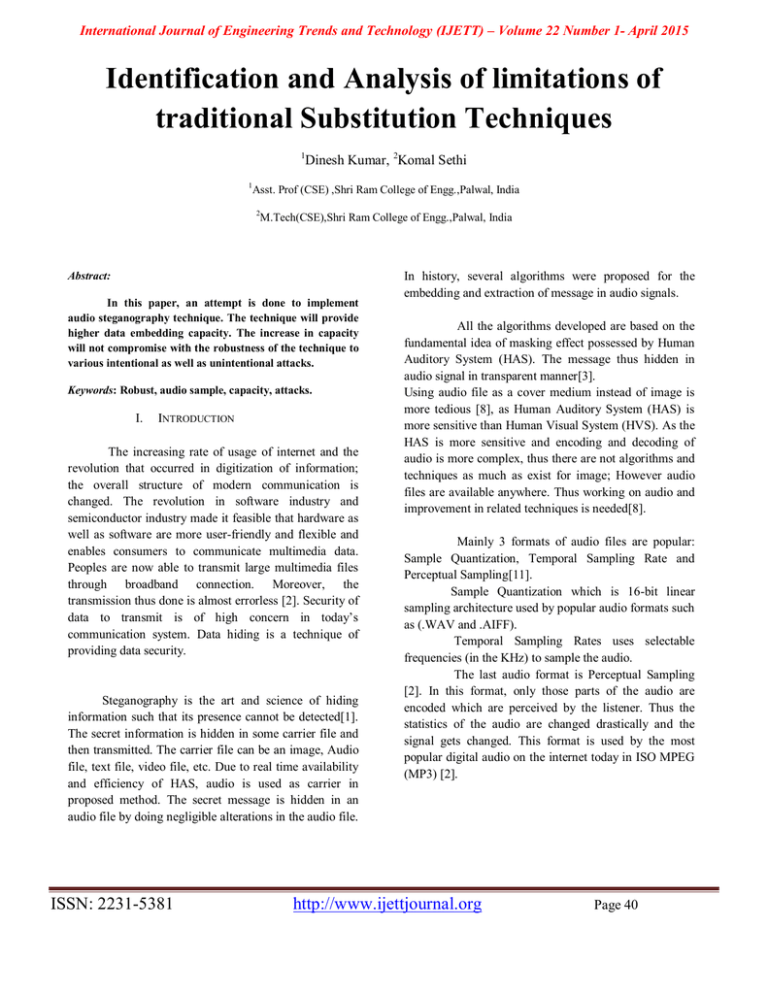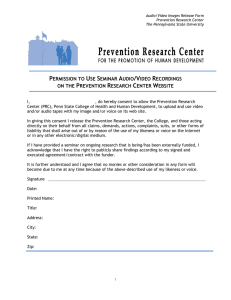Identification and Analysis of limitations of traditional Substitution Techniques
advertisement

International Journal of Engineering Trends and Technology (IJETT) – Volume 22 Number 1- April 2015 Identification and Analysis of limitations of traditional Substitution Techniques 1 Dinesh Kumar, 2Komal Sethi 1 Asst. Prof (CSE) ,Shri Ram College of Engg.,Palwal, India 2 M.Tech(CSE),Shri Ram College of Engg.,Palwal, India Abstract: In this paper, an attempt is done to implement audio steganography technique. The technique will provide higher data embedding capacity. The increase in capacity will not compromise with the robustness of the technique to various intentional as well as unintentional attacks. Keywords: Robust, audio sample, capacity, attacks. I. INTRODUCTION The increasing rate of usage of internet and the revolution that occurred in digitization of information; the overall structure of modern communication is changed. The revolution in software industry and semiconductor industry made it feasible that hardware as well as software are more user-friendly and flexible and enables consumers to communicate multimedia data. Peoples are now able to transmit large multimedia files through broadband connection. Moreover, the transmission thus done is almost errorless [2]. Security of data to transmit is of high concern in today’s communication system. Data hiding is a technique of providing data security. Steganography is the art and science of hiding information such that its presence cannot be detected[1]. The secret information is hidden in some carrier file and then transmitted. The carrier file can be an image, Audio file, text file, video file, etc. Due to real time availability and efficiency of HAS, audio is used as carrier in proposed method. The secret message is hidden in an audio file by doing negligible alterations in the audio file. ISSN: 2231-5381 In history, several algorithms were proposed for the embedding and extraction of message in audio signals. All the algorithms developed are based on the fundamental idea of masking effect possessed by Human Auditory System (HAS). The message thus hidden in audio signal in transparent manner[3]. Using audio file as a cover medium instead of image is more tedious [8], as Human Auditory System (HAS) is more sensitive than Human Visual System (HVS). As the HAS is more sensitive and encoding and decoding of audio is more complex, thus there are not algorithms and techniques as much as exist for image; However audio files are available anywhere. Thus working on audio and improvement in related techniques is needed[8]. Mainly 3 formats of audio files are popular: Sample Quantization, Temporal Sampling Rate and Perceptual Sampling[11]. Sample Quantization which is 16-bit linear sampling architecture used by popular audio formats such as (.WAV and .AIFF). Temporal Sampling Rates uses selectable frequencies (in the KHz) to sample the audio. The last audio format is Perceptual Sampling [2]. In this format, only those parts of the audio are encoded which are perceived by the listener. Thus the statistics of the audio are changed drastically and the signal gets changed. This format is used by the most popular digital audio on the internet today in ISO MPEG (MP3) [2]. http://www.ijettjournal.org Page 40 International Journal of Engineering Trends and Technology (IJETT) – Volume 22 Number 1- April 2015 II. RELATED WORK K.P. Adhiya and Swati A. Patil proposed a steganographic method for embedding textual information in audio. In this method, each audio sample is converted into bits and then the textual information is embedded in it. The last 4 bits of this binary is taken into consideration and applying redundancy of the binary code the prefix either 0 or 1 is used. In the method 16bit WAV and 8bit WAV audio file are supported. The proposed algorithm gives better result for 16 bit wave audio as compared to 8 bit [4]. Prof. Samir Kumar Bandyopadhyay and Barnali Gupta Banik give an overview of two primitive techniques to get an idea of how steganography in audio file works. LSB modification and Phase Encoding techniques are very primitive in steganography. This method is easy to implement but is very susceptible to data. This method can be used only when a small amount of data needs to be concealed [5,7]. Jayaram P, Ranganatha H R, Anupama H S discuss different type of audio steganographic methods, advantages and disadvantages. They proposed that audio data hiding techniques can not only be used for secure communication but also for some other purposes like data storage, tracing information, finger printing and tamper detection, etc [6]. R Sridevi, Dr. A Damodaram and Dr. SVL. Narasimha give basic idea behind to provide an efficient method for data hiding. The data will be secure from hackers and send to the destination in a more secure and safe way. The size of cover audio does not change after encoding even the system supports so many formats. The quality of sound was a consequence of the message length that is to be hidden and the size of the audio file that serves as cover [9]. III. SUBSTITUTION TECHNIQUES OF AUDIO STEGANOGRAPHY Initially steganographic systems were developed for digital images and video files. Later on with the tremendous increase in use of digital audio for multimedia communication the interest moved towards audio steganography. There are so many attacks that are malicious against ISSN: 2231-5381 Figure 1. Audio Steganography Process image steganography algorithms (e.g. geometrical distortions, spatial scaling, etc.) but when these attacks are tested against audio steganography techniques, they were not as much effective. Moreover there are not so many steganalysis techniques that can be used by attackers against audio steganography. The substitution technique is based on the idea that if a single bit or a few bits in each audio sample are replaced with the message bits then the change thus occurred will not be noticeable to the human ear (type of file matters). The capacity of this method is very high (41,000 bps). The robustness of this method is very low. This method is however easy to implement but susceptible to various attacks. The prime reason for choosing this technique lies in the advantage of using substitution technique which is a very high capacity for hiding a message. When only single LSB replacement is done per host audio sample a capacity of 44.1 kbps can be achieved. However there are certain other techniques like spread spectrum (4 bps) having lesser capacity but they are more robust. [10]. IV. LIMITATIONS OF TRADITIONAL SUBSTITUTION TECHNIQUES A multimedia technique is said to be good if it satisfies three basic requirements: Perceptual Transparency, Capacity of Hidden data and Robustness. http://www.ijettjournal.org Page 41 International Journal of Engineering Trends and Technology (IJETT) – Volume 22 Number 1- April 2015 The same rule must be hold for audio steganography techniques. 1) Steganography Attacks: In order to analyze a steganography technique, the knowledge about attacks is necessary A. Active and Passive Attacks The steganography techniques can be categorized as of two types: one that tries to reveal the message and another one that tries to destroy the hidden message. Substitutions techniques are vulnerable against both types of attacks. The attack that tries to reveal the hidden message must have the knowledge of hiding process. Since the bits of lower layers are the targets for replacement in substitution techniques, it is not much difficult to reveal the hidden message as the suspicious transmission due to low transparency may drive attention. B. Intentional and Un-intentional Attacks One more categorization of attacks can be intentional and unintentional attacks. The unintentional attacks like noise, transition distortions could destroy the hidden message without intention. The chances are more if it is hidden in the bits of lower layers in the sample LSBs. The above discussion can be summarized as following problems of substitution techniques of audio steganography: 1) Low robustness against intentional attacks which try to reveal the hidden message. 2) Low robustness against distortions with high average power (unintentional attacks). One possible solution to withstand intentional attacks that tries to reveal the message is making more difficult discovering which bits are modified. As it is known that LSBs are more suspicious, thus if the embedding is done in the bits other than LSBs then it would be helpful to increase the robustness against intentional attacks. Furthermore the statistical values of the sample are changed after embedding process. Audio sample: 10011101 (value 157) Message bits: 0 and 1 After substitution: 10010101 (value 149) From above discussion, the following two consequences of above mentioned problems are summarized as follows: 1) Make the embedding process more difficult somehow so that heuristics should not work easily for attackers about the presence of message. 2) In-order to be robust from data loss due to noises, compression and other operations done on audio file, use of bits in deeper layers for substitution can be a possibility; however movement towards MSB’s will lead to more distortion produced. Conclusively both the above points can be combined by embedding the message bits in deeper layers; that is by substituting the bits towards MSB side. This will however introduce the more distortion. Now the research will proceed for developing an algorithm that will implement above two points while minimizing the distortion introduced. VI. CONCLUSION The basic problems in using substitution techniques are identified and various conclusions are then derived. This paper analyses the problems encountered in traditional substitution techniques in audio steganography. One problem is that they are less robust against intentional attacks that try to reveal hidden message and second problem is having low robustness against unintentional attacks like distortions with high average power. The future research will be focused on developing an algorithm to hide the message in deeper layers of audio sample and to minimize the distortion thus induced somehow. In order to increase the capacity the method currently will use 2 bits per byte of audio sample for substitution. This will progress towards achieving higher capacity and robustness. VII. From above example, it is clearly seen that the statistical value of audio sample is changed significantly. This change will result in significant distortion in the stego file making it more vulnerable to arise suspicion. ISSN: 2231-5381 V. PROBLEM STATEMENT REFRENCES [1]. Rohit Tanwar, Sunil Kumar, Narender Gautam, Ravinder Gautam,” A Spatial Domain Steganography Technique Based on Optimal Solution Using Genetic Algorithm”, January 2013,Page(s):228-232.ISBN:978-93-81583-82-1 http://www.ijettjournal.org Page 42 International Journal of Engineering Trends and Technology (IJETT) – Volume 22 Number 1- April 2015 [2]. Gunjan Nehru, Puja Dhar,”A detailed look of audio steganographic techniques using LSB and Genetic Algrithm approach”, IJCSI Vol.9, Issue1, No.2, January 2012 ISSN(online): 1694-0814. [3]. Juhi Saurabh, Asha Ambhaikar,”Audio Steganography using RPrime RSA and GA Based algorithm to enhance security”, IJSR (online) ISSN:2319-7064, Vol-1,Issue-2, November 2012. [4]. K.P.Adhiya and Swati A. Patil, " Hiding Text in Audio Using LSB Based Steganography" in Information and Knowledge Management Vol. 2, No.3, 2012. [5]. Prof. Samir Kumar Bandyopadhyay and Barnali Gupta Banik , "LSB Modification and Phase Encoding Technique of Audio Steganography Revisited" in International Journal of Advanced Research in Computer and Communication Engineering Vol. 1, Issue 4, June 2012. [6]. Jayaram P, Ranganatha H R, Anupama H S, " INFORMATION HIDING USING AUDIO STEGANOGRAPHY – A SURVEY" in The International Journal of Multimedia & Its Applications (IJMA) Vol.3, No.3, August 2011. [7]. Samir Kumar Bandyopadhyay and Biswajita Datta" Higher LSB Layer Based Audio Steganography Technique" in IJECT Vol. 2, Issue 4, Oct . - Dec . 2011 [8]. Zamani, M. Manaf, A.A. , Ahmad, R.B., Zeki, A.M., & Abdullah, S.”A genetic algorithm based approach for audio steganography”, World Academy of Science, 2009 [9]. R SRIDEVI, DR. A DAMODARAM, DR. SVL. NARASIMHAM, “Efficient Method of Audio Steganography by Modified LSB Algorithm and Strong Encryption Key with Enhanced Security”, in Proc. JATIT PP:768-771,2005-2009. [10]. Bret Dunbar, “A Detailed Look at Steganographic Systems and their Use in Open-Systems Environment” in SANS Institute Infosec Reading room, August 01, 2002,url:http://www.sans.org/readingroom/whitepapers/co vert/detailed-steganographic-techniques-open-systemsenvironment-677 [11]. Pal S.K., Saxena P.K. and Mutto S.K, “The Future of Audio Steganography”, Pacific Rim Workshop on Digital Steganography, Japan, 2002. ISSN: 2231-5381 http://www.ijettjournal.org Page 43





